
The First of Their Name Trivia Quiz
The Norman conquest of England ended the reigns of the previous Anglo-Saxon kings and introduced new and significant changes to English society. In the next thousand years, there were 14 different regnal names used - but when was each first used?
An ordering quiz
by reedy.
Estimated time: 3 mins.